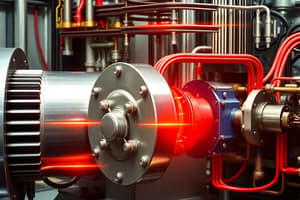Podcast
Questions and Answers
What is the primary purpose of braking in a DC motor?
What is the primary purpose of braking in a DC motor?
- To dissipate excess energy (correct)
- To reduce the motor torque
- To change the motor direction
- To increase the motor speed
Which type of control is used in a Ward Leonard drive?
Which type of control is used in a Ward Leonard drive?
- Voltage control (correct)
- Current limit control
- Chopper control
- Time ratio control
What is the primary advantage of using a controlled rectifier fed DC drive?
What is the primary advantage of using a controlled rectifier fed DC drive?
- Reduced motor torque
- Increased motor current
- Improved motor efficiency
- Variable motor speed (correct)
What is the effect of ripples on the DC motor performance?
What is the effect of ripples on the DC motor performance?
Which type of operation is used in a four-quadrant DC drive?
Which type of operation is used in a four-quadrant DC drive?
Flashcards are hidden until you start studying
Study Notes
DC Motor and Performance
- A DC motor's performance is affected by various factors, including braking, transient analysis, and drive control methods.
Braking
- Braking in DC motors is essential to control the motor's speed and bring it to a stop.
- There are different braking methods, including regenerative braking, dynamic braking, and rheostatic braking.
Transient Analysis
- Transient analysis is used to study the behavior of a DC motor during sudden changes in load or supply voltage.
- It helps in understanding the motor's dynamic response and stability.
Ward Leonard Drives
- Ward Leonard drives are a type of DC motor drive that uses an AC motor, a generator, and an exciter to control the DC motor's speed.
- They are known for their smooth speed control and high efficiency.
Transformer and Uncontrolled Rectifier Control
- Uncontrolled rectifier control uses a transformer and a diode bridge to convert AC voltage to DC voltage.
- It is a simple and cost-effective method, but lacks flexibility in terms of speed control.
Controlled Rectifier Fed DC Drives
- Controlled rectifier fed DC drives use a controlled rectifier, such as a thyristor bridge, to convert AC voltage to DC voltage.
- They offer improved speed control and high efficiency compared to uncontrolled rectifier control.
Chopper Controlled DC Drives
- Chopper controlled DC drives use a high-frequency switch, such as a thyristor or power transistor, to chop the DC voltage and control the motor's speed.
- They offer high efficiency, rapid response, and regenerative braking capabilities.
Time Ratio Control and Current Limit Control
- Time ratio control adjusts the on-off duration of the chopper switch to control the motor's speed.
- Current limit control limits the motor current to prevent overheating and damage.
Single, Two, and Four Quadrant Operations
- Single-quadrant operation involves forward motoring, where the motor runs in one direction.
- Two-quadrant operation involves forward motoring and braking in one direction.
- Four-quadrant operation involves forward and reverse motoring, as well as forward and reverse braking.
Effect of Ripples on DC Motor Performance
- Ripples in the DC voltage supply can affect the motor's performance, causing vibrations, noise, and reduced efficiency.
- Ripple reduction techniques, such as filtering and smoothing, are used to minimize the impact of ripples on motor performance.
Studying That Suits You
Use AI to generate personalized quizzes and flashcards to suit your learning preferences.





